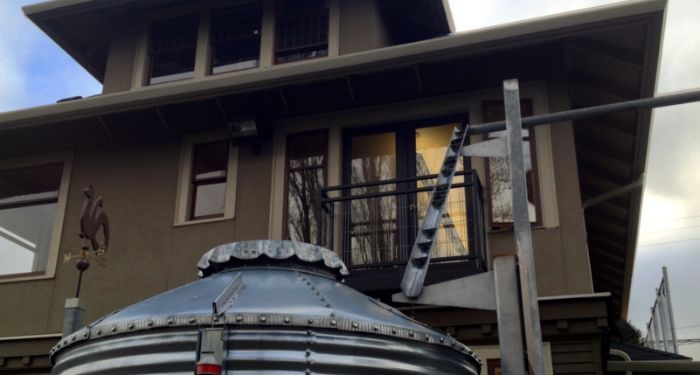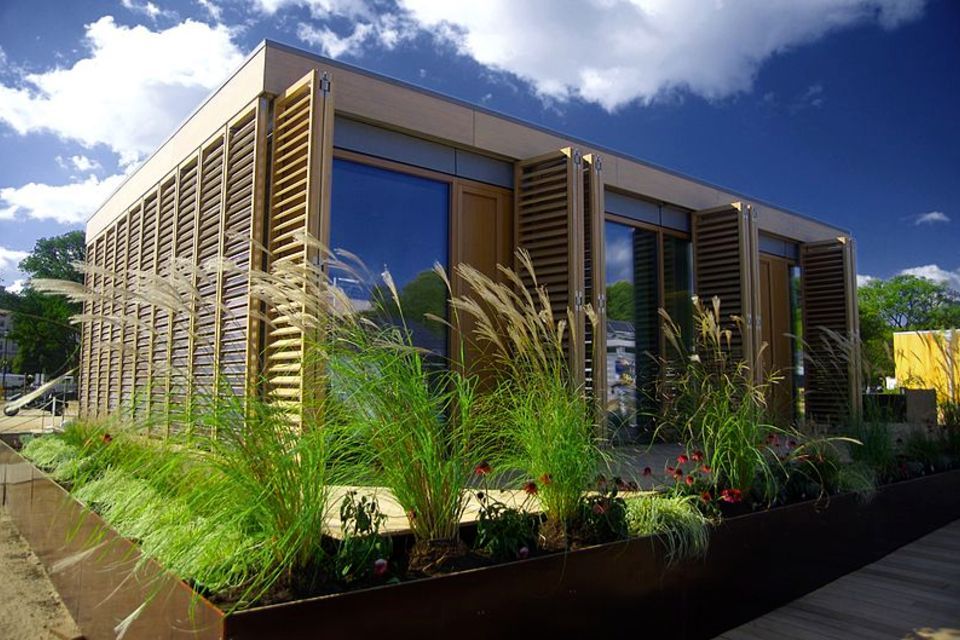Introduction
In recent years, there has been a growing popularity in off-grid living, in most cases through having a self-sufficient home.
In our guide to self-sustaining homes, we will discuss what a self-sustaining home is, ways to create a self-sustaining home and the benefits of having one.
Our guide will be particularly useful if you are planning to have a self-sustaining home someday or if you simply want to expand your knowledge on the subject for the time being.
What is a Self-Sustaining Home?

For this section, we will discuss what a self-sustaining home is. We will also explain why they have become popular and look at the reasons why people are converting to self-sustaining homes.
Self-sufficient homes produce their own electricity such as from solar panels, these homes are used by the occupants to grow their own food, manage their waste and a self-sustaining home should have a means of providing heat.
Self-sustaining homes are often also known as off-grid homes since they are off the electricity grid and cut off from food and heating supply chains.
Hybrid versions exist whereby the occupants are largely off-grid but may connect to the electricity grid and utilise other external suppliers if needed.
In many cases they may be mostly cut off from external suppliers but not entirely. One of the key reasons for the rise in popularity in self-sustaining homes is the environmental benefits.
It also offers homeowners the opportunity to take their food and energy supplies into their own hands, save money by cutting down on expenses and to gain an experience of greater independence and a sense of being cut-off from the world at large.

Many people are converting to self-sustaining homes to reduce their carbon footprint, bring down their expenses and increase their preparedness for a disaster or economic downturn.
In the case of the latter scenarios, living in a self-sustained home will leave homeowners less vulnerable to changes taking place in the world at large.
Having a self-sustained home can also increase security for the future as it will allow occupants to save money due to lowered expenses and also give homeowners the chance to stock up on food and energy if necessary.

Many people who live off-grid are concerned with how climate change may severely impact civilisation in the coming decades and believe that living in a self-sustained home will be the best bet to live as safely as possible through such a scenario.
Ways to Create a Self-Sustaining Home?
We will now explore the steps you might take to create a self-sustaining home. We will delve into subtopics such as composting, vegetable gardens and solar panels.
Composting
For this subsection, we will discuss composting, looking at how someone can compost and how much a compost bin costs among other relevant areas of discussion.
Compost consists of decayed organic matter. By composting, an individual may add the remains and leftovers of fruits and vegetables (i.e.; banana skins) to create compost, a nutrient-rich fertiliser which can be used to support plant growth.
Animal and even human excrement may be added in some cases although specific guidelines need to be followed to ensure that the excrement does not create a harmful fertiliser.

In order to create compost, you should first find a suitable outdoor space, such as in your back garden of at least one square metre. You’ll then need to utilise a compost bin, preferably a closed one so that the smells from inside won’t travel too far.
You should line your compost bin internally with biodegradable bags. Next, you’ll need to start adding organic material, plenty of which will exist in your garden and kitchen alike.
After adding organic matter to your compost bin, give it a few weeks for the material to break down and transform into compost. Once the composting process is complete, you can use this compost as a fertiliser for growing crops.

A compost bin is exactly what it says on the tin. Some compost bins are designed to quicken the decomposition of organic material such as through their aeration capabilities and ability to absorb moisture.
A regular compost bin will likely cost you between £10 and £20. However, higher quality bins are likely to cost about £50.
Organic matter that can be added to a compost bin includes but is not limited to coffee grounds, tea bags, hair, egg shells, fruit skins or leftovers, the leftovers of vegetables and cut flowers. It goes without saying that anything non-organic should not be added.
You should avoid adding animal products (including dairy), pet waste, oil and fats to a compost bin. While these products are compostable, they will give off a smell and attract insects.

Plants which have died from disease should also not be added to a compost bin as these too could attract pests.
As an alternative to purchasing a product in a store, composting can help to make a home self-sustaining as it provides you with your own fertiliser. It won’t help you cut down on utility bills but it will increase the independence of your household.
Vegetable Garden
We will now take a look at what is involved in creating a vegetable garden. In order to begin a vegetable garden, you should first find a suitable spot on your land for growing vegetables.
The spot you choose should not be heavily shaded as your vegetables will need plenty of sunlight. You should work on one given area at a time.
Next, you need to design the vegetable plot you are planning to create, pull out any weeds, find the right soil and then begin growing crops that are easier to grow and sustain, at least as a starting point.

Of course, how much space you’ll need for your vegetable plots will depend on what you’re planning to grow and how many vegetables you intend to cultivate. Look at the packet of seeds you’ve purchased to find out how much space each given vegetable will require.
A popular approach to calculating how much space you’ll need between each row of vegetables is to add the row spacing requirements for the two rows of different vegetables and then divide by two. The number you get is the distance that should exist between these two rows.
By using this approach in general, you can work out how much space you’ll need as a whole to grow X amount of vegetable rows based on the types of vegetables that you intend to grow.
Some easy beginner vegetables you may choose to grow include potatoes, peas, spring onions, tomatoes, beetroot and salad leaves. Some of the best vegetables to grow at home are broccoli, potatoes, asparagus, tomatoes and lettuce. These vegetables are particularly cost-effective and most are easy to grow.

To run a vegetable garden will probably cost you several hundred pounds per year, possibly more depending on the size of the plots in question.
A vegetable garden can increase the self-sustainability of your home as it will allow you to grow at least some of your own food. This will reduce your food expenses as a result.
Rainwater Collection
We will now discuss rainwater collection as a way to help create a self-sustaining home. Collecting rainwater is the process of harvesting rain that has fallen from the sky and using it for a range of different purposes.

Collected rainwater may be used to water plants, flush toilets, refill a swimming pool and for doing the laundry among many other applications. There are various approaches to harvesting rainwater. It is commonplace to use rain barrels to collect rainwater.
In many cases, this will be placed below a gutter downspout so that water collected on the roof’s gutter will pour into the barrel. A dry system can be used whereby a collection pipe takes water from the roof’s gutters.
Cheaper options include the use of a small inflatable pool, watering cans or a pot in order to harvest rainwater. The cost of a rain barrel may come to somewhere between £20 and £200.
To have a high-quality rainwater collection system installed may cost you between £2000 and £3000. The aforementioned cheaper alternatives will likely only come to between £5 and £20.

By collecting rainwater you can reduce your reliance on an external water supplier and with a high quality and highly effective rainwater collection, system it is possible to be entirely self-reliant in this regard.
Of course, for certain applications, a high quality filtration system will be needed especially if you are planning to use the water for consumption purposes. Rainwater harvesting can of course bring down your water bills.
You may save between 40% and 50% on your water bills as a result of collecting rainwater or possibly more, depending on the quality and scale of your collection system.

Wood Burners
In this subsection, we will discuss the benefits of wood burners for creating a self-sustaining home. A wood burner is a stove that can be used to burn wood logs in order to produce heat.
To have a wood burner installed will likely cost you between £1500 and £2700 although more affordable wood burners are available for just several hundred pounds.

Wood burners are used as a cheaper and more environmentally friendly way of heating your room although exactly how environmentally friendly a wood burner is will depend on the type of wood used.
Utilising a wood burner will reduce how much you depend on an external heating supplier. As a result, this can bring down your heating bill.
Solar Panels

The installation of solar panels is especially popular among those living an off-grid lifestyle. Solar panels harness the energy of the sun by allowing light particles to bounce off electrons, freeing them from atoms in order to produce an electrical flow. A single 300 watt solar panel will probably cost you between £400 and £600.
You may need to spend around £4000 to £6000 to install enough solar panels (about ten 300 watt panels) to sustain your home, based on the average energy consumption of a UK household.
Ten 300 watt solar panels would make up a 3 kilowatt solar panel system. The greater your electrical needs, the more you’ll need to spend and vice versa.

Not all homes are suitable for solar panels. Obviously, you first need to ensure that your roof has adequate access to sunlight and is not extensively blocked such as by very tall trees.
If you want to be entirely reliant on solar energy, you will require roof space of about 15 to 21m² and a roof that can easily sustain a weight of 300-400kgs as the combined weight of all solar panels.
You will also need to consider whether your roof is particularly old and how well it could handle the weight of ten or so solar panels.

Other concerns you will need to consider is planning permission. You probably won’t need such permission as long as your home is not situated in a conservation area and that your solar panels aren’t hanging off the side of your roof. However, you should ask your installer about this issue if you are uncertain about anything.
Having solar panels installed on your roof can increase, if not maximise your independence from external electricity suppliers.
As a consequence, you will at a minimum, save massively on your electricity bills. If you depend completely on your solar panels you can remove your electricity bills entirely.
Utilise Recycled Material
Another way to improve the self-sufficiency of your home is to make use of recycled materials. There are countless possibilities when it comes to utilising recycled materials.
An example of utilising recycled materials could be using old textile materials to make a new quilt, create a wind chime from jar lids and pieces of string, mix the remains of old crayons to create new ones and put together a bird feeder using recycled materials among many other applications.

There is of course no cost involved in the process of recycling material. All you need to do is spend a little time and energy putting these items together.
By using recycled material to create new items you can reduce your reliance on external suppliers and reduce your expenses.
Benefits of Having a Self-Sustaining Home
In this section, we will discuss the various advantages of having a self-sustaining home. Such benefits include reducing expenses, having a more environmentally friendly home and adding value to your property.
Save Money
The more self-sufficient your home is, the more money you can save. You can cut down on expenses such as food and water as well as bring down your bills such as for water, heating and electricity.
Another expense you could save on is compost. You may also be able to benefit financially by selling quantities of what you have such as by selling your solar energy back to the grid during the summer months. Selling home grown produce such as fruits and vegetables could act as another additional source of income.
Environmentally Friendly
One of the most popular advantages of a self-sustaining home is its environmental benefits. By self-producing your own electricity and heating through renewable energy such as solar power and wood burners respectively, you can significantly reduce your carbon footprint.

Growing food at home and producing your own compost will also mean you can cut down on or avoid purchasing products from stores which can come with a carbon footprint due to how they were produced and from the transportation involved in getting such products to the store in the first place.
Further, by producing your own food, you will reduce your carbon footprint by cutting out the need to travel to nearby shops or at least reducing the amount of trips you’ll need to take.
Add Value to Property
By converting your home to one that is self-sustaining, you can increase the value of your property. A home with solar panels present on the roof as well as other applications such as a vegetable garden and a rainwater collection system will increase the value of your home.
This is because those seeking to live in a self-sustaining home may be more inclined to purchase a home that is ready for a self-sufficient lifestyle rather than spending money on converting a regular house.
Even those who do not plan to live in an entirely self-sufficient manner will see the benefits of purchasing a home with applications such as a rainwater collection system and solar panels.
Disaster Preparedness
Should a disaster strike in your area such as a natural disaster or if there is a major economic downturn, by living off-grid, you will be more prepared for such outcomes.
A self-sustaining home can allow you to continue to produce and have access to the same amount of food as usual. Solar power will mean that you will not be impacted should there be a sudden and major power outage in your region.
The ongoing coronavirus pandemic recently highlighted concerns regarding food and utility shortages which can result from a sudden spike in demand.
By having a self-sustaining home, you can reduce how much you depend on supply chains so that you will be left less vulnerable to being negatively impacted by events that are out of your control.
FAQs
Q: How long does it take to make compost?
A: Compost may take 6-8 weeks to fully form.
Q: Is it illegal to collect rainwater?
A: It is not against the law to simply collect rainwater in the UK. However, you are legally obligated to keep non-potable water away from any drinking water supplies. More information is available on the Rainharvesting Systems’ website.
Q: Where can I buy solar panels from?
A: There are many solar panel suppliers across the UK. You can find dozens online and you may also purchase solar panels through sites such as Amazon and eBay. You will also need to consider who you will pay to install your solar panels. You may choose to use a service such as Spirit Energy to supply and install your solar panels.
Q: What types of fruit can I grow in the UK?
A: In the UK, it’s possible to grow fruit such as grapes, melons, apples, cherries, plums, strawberries and many other fruits.
Q: How long does a solar panel last?
A: A solar panel will last for 20-30 years on average. In some cases, solar panels can even last for four decades or longer.
Sources
- https://morningchores.com/self-sustaining-homes/
- https://sustainablelivingassociation.org/the-rise-of-eco-friendly-homes/
- https://www.greenmatters.com/food/2018/12/07/ZboPlt/what-is-composting
- https://www.gardeningknowhow.com/composting/manures/dog-waste-in-compost.htm
- https://www.gardenersworld.com/plants/starting-a-new-vegetable-patch/
- https://schoolgardening.rhs.org.uk/Resources/Info-Sheet/Vegetable-crop-planner
- https://www.thompson-morgan.com/top-10-easy-to-grow-vegetables
- https://www.countryliving.com/uk/homes-interiors/gardens/a20120884/most-cost-effective-vegetables-grow-home-garden/
- https://www.watercache.com/education/rainwater-harvesting-101
- https://www.renewableenergyhub.co.uk/main/rainwater-harvesting-information/cost-of-installing-rainwater-harvesting-system/
- https://www.rainharvesting.co.uk/rainwater-harvesting-system-can-help-save-money-housing-development/
- https://www.which.co.uk/news/2017/12/is-buying-a-log-burner-or-multi-fuel-stove-worth-the-cost/
- https://www.livescience.com/41995-how-do-solar-panels-work.html
- https://www.evergreenenergy.co.uk/solar-panels/is-my-home-suitable-for-solar-panels/
- https://www.gardenorganic.org.uk/how-do-i-make-my-compost
- https://www.rhs.org.uk/advice/grow-your-own/fruit







